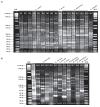Identification and characterization of potential probiotic lactic acid bacteria isolated from pig feces at various production stages
- PMID: 37020571
- PMCID: PMC10069149
Identification and characterization of potential probiotic lactic acid bacteria isolated from pig feces at various production stages
Abstract
Lactic acid bacteria (LAB) were isolated, identified, and characterized from pig feces at various growth stages and feed rations in order to be used as probiotic feed additives. Lactic acid bacteria numbers ranged from 7.10 ± 1.50 to 9.40 log CFUs/g for growing and lactating pigs, respectively. Isolates (n = 230) were identified by (GTG)5-polymerase chain reaction and partial sequence analysis of 16S rRNA. Major LAB populations were Limosilactobacillus reuteri (49.2%), Pediococcus pentosaceus (20%), Lactobacillus amylovorus (11.4%), and L. johnsonii (8.7%). In-vitro assays were performed, including surface characterization and tolerance to acid and bile salts. Several lactobacilli exhibited hydrophobic and aggregative characteristics and were able to withstand gastrointestinal tract conditions. In addition, lactobacilli showed starch- and phytate-degrading ability, as well as antagonistic activity against Gram-negative pathogens and the production of bacteriocin-like inhibitory substances. When resistance or susceptibility to antibiotics was evaluated, high phenotypic resistance to ampicillin, gentamicin, kanamycin, streptomycin, and tetracycline and susceptibility towards clindamycin and chloramphenicol was observed in the assayed LAB. Genotypic characterization showed that 5 out of 15 resistance genes were identified in lactobacilli; their presence did not correlate with phenotypic traits. Genes erm(B), strA, strB, and aadE conferring resistance to erythromycin and streptomycin were reported among all lactobacilli, whereas tet(M) gene was harbored by L. reuteri and L. amylovorus strains. Based on these results, 6 probiotic LAB strains (L. reuteri F207R/G9R/B66R, L. amylovorus G636T/S244T, and L. johnsonii S92R) can be selected to explore their potential as direct feed additives to promote swine health and replace antibiotics.
Des bactéries lactiques (LAB) ont été isolées, identifiées et caractérisées à partir de matières fécales de porc à différents stades de croissance et de rations alimentaires afin d’être utilisées comme additifs alimentaires probiotiques. Le nombre de bactéries lactiques variait de 7,10 ± 1,50 à 9,40 log UFC/g pour les porcs en croissance et en lactation, respectivement. Les isolats (n = 230) ont été identifiés par réaction d’amplification en chaîne par la (GTG)5-polymérase et analyse partielle de la séquence de l’ARNr 16S. Les principales populations de LAB étaient Limosilactobacillus reuteri (49,2 %), Pediococcus pentosaceus (20 %), Lactobacillus amylovorus (11,4 %) et L. johnsonii (8,7 %). Des tests in vitro ont été effectués, y compris la caractérisation de surface et la tolérance aux acides et aux sels biliaires. Plusieurs lactobacilles présentaient des caractéristiques hydrophobes et agrégatives et étaient capables de résister aux conditions du tractus gastro-intestinal. De plus, les lactobacilles ont montré une capacité de dégradation de l’amidon et des phytates, ainsi qu’une activité antagoniste contre les agents pathogènes à Gram négatif et la production de substances inhibitrices de type bactériocine. Lorsque la résistance ou la sensibilité aux antibiotiques a été évaluée, une résistance phénotypique élevée à l’ampicilline, à la gentamicine, à la kanamycine, à la streptomycine et à la tétracycline et une sensibilité à la clindamycine et au chloramphénicol ont été observées dans les LAB testés. La caractérisation génotypique a montré que cinq gènes de résistance sur 15 ont été identifiés dans les lactobacilles; leur présence n’était pas corrélée aux traits phénotypiques. Les gènes erm(B), strA, strB et aadE conférant une résistance à l’érythromycine et à la streptomycine ont été signalés parmi tous les lactobacilles, tandis que le gène tet(M) était hébergé par les souches L. reuteri et L. amylovorus. Sur la base de ces résultats, six souches probiotiques LAB (L. reuteri F207R/G9R/B66R, L. amylovorus G636T/S244T et L. johnsonii S92R) peuvent être sélectionnées pour explorer leur potentiel en tant qu’additifs alimentaires directs pour promouvoir la santé des porcs et remplacer les antibiotiques.(Traduit par Docteur Serge Messier).
Copyright and/or publishing rights held by the Canadian Veterinary Medical Association.
Figures




Similar articles
-
Selection and characterization of probiotic lactic acid bacteria and its impact on growth, nutrient digestibility, health and antioxidant status in weaned piglets.PLoS One. 2018 Mar 8;13(3):e0192978. doi: 10.1371/journal.pone.0192978. eCollection 2018. PLoS One. 2018. PMID: 29518093 Free PMC article.
-
Characterization and anti-salmonella activities of lactic acid bacteria isolated from cattle faeces.BMC Microbiol. 2018 Aug 30;18(1):96. doi: 10.1186/s12866-018-1248-y. BMC Microbiol. 2018. PMID: 30165820 Free PMC article.
-
Genotypic characterization and safety assessment of lactic acid bacteria from indigenous African fermented food products.BMC Microbiol. 2012 May 17;12:75. doi: 10.1186/1471-2180-12-75. BMC Microbiol. 2012. PMID: 22594449 Free PMC article.
-
In vitro evaluation of the safety and probiotic properties of Lactobacilli isolated from chicken and calves.Anaerobe. 2014 Oct;29:118-27. doi: 10.1016/j.anaerobe.2013.10.009. Epub 2013 Nov 27. Anaerobe. 2014. PMID: 24291759
-
Anti-cancer Substances and Safety of Lactic Acid Bacteria in Clinical Treatment.Front Microbiol. 2021 Oct 12;12:722052. doi: 10.3389/fmicb.2021.722052. eCollection 2021. Front Microbiol. 2021. PMID: 34721321 Free PMC article. Review.
Cited by
-
Alleviating Pentatrichomonas hominis-induced damage in IPEC-J2 cells: the beneficial influence of porcine-derived lactobacilli.Vet Res Commun. 2024 Aug;48(4):2331-2342. doi: 10.1007/s11259-024-10414-z. Epub 2024 May 21. Vet Res Commun. 2024. PMID: 38771449
-
Probiotic Potential of Pediococcus pentosaceus M6 Isolated from Equines and Its Alleviating Effect on DSS-Induced Colitis in Mice.Microorganisms. 2025 Apr 22;13(5):957. doi: 10.3390/microorganisms13050957. Microorganisms. 2025. PMID: 40431130 Free PMC article.
-
Panax notoginseng stems and leaves affect microbial community and function in cecum of duzang pigs.Transl Anim Sci. 2024 Jan 22;8:txad142. doi: 10.1093/tas/txad142. eCollection 2024. Transl Anim Sci. 2024. PMID: 38425544 Free PMC article.
References
-
- Centro de Información de Actividades Porcinas [homepage on the Internet] [Last accessed February 11, 2023]. Available from: http://www.ciap.org.ar/Sitio/Sipu/Noticias/Busqueda-Noticias.jsp.
-
- Cao G, Tao F, Hu Y, et al. Positive effects of a Clostridium butyricum-based compound probiotic on growth performance, immune responses, intestinal morphology, hypothalamic neurotransmitters, and colonic microbiota in weaned piglets. Food Funct. 2019;10:2926–2934. - PubMed
MeSH terms
Substances
LinkOut - more resources
Full Text Sources
Miscellaneous
